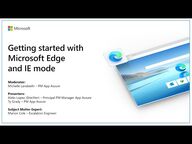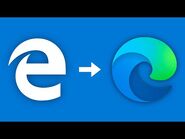Microsoft Edge ![]() is a cross-platform web browser developed by Microsoft, released in 2015 for Windows 10 and Xbox One, for Android and iOS in 2017,[1] for macOS in 2019,[2] and for Linux in 2020;[3] it can replace Internet Explorer on Windows 7, Windows Server 2008 R2 and later versions but unlike IE, this browser does not support Windows Vista and earlier versions. The Chromium-based Edge replaced Internet Explorer (IE) in Windows 11 as the default browser.
is a cross-platform web browser developed by Microsoft, released in 2015 for Windows 10 and Xbox One, for Android and iOS in 2017,[1] for macOS in 2019,[2] and for Linux in 2020;[3] it can replace Internet Explorer on Windows 7, Windows Server 2008 R2 and later versions but unlike IE, this browser does not support Windows Vista and earlier versions. The Chromium-based Edge replaced Internet Explorer (IE) in Windows 11 as the default browser.
Edge was initially built with Microsoft's own proprietary browser engine EdgeHTML and their Chakra JavaScript engine, a version now referred to as Microsoft Edge Legacy. It was later rebuilt as a Chromium-based browser using the Blink and V8 engines.
It is designed to be a lightweight web browser with a layout engine built around web standards. It does not support ActiveX, Browser Helper Objects or Adobe Flash Player. However, it adds new features such as integration with Cortana, annotation tools, and a reading mode. Extension support was added to Edge with the release of the Windows 10 Anniversary Update on August 2, 2016.
Edge is the fourth most popular desktop web browser as of 2022.[4] Microsoft remains third among browser development companies when including legacy Internet Explorer users.[5]
Features[]
Microsoft Edge is the default web browser on Windows 10, Windows 11, Windows 10 Mobile, Xbox One and Xbox Series X and Xbox Series S consoles, replacing Internet Explorer 11 and Internet Explorer Mobile.[6]
Microsoft initially announced that Edge would support the legacy MSHTML (Trident) browser engine for backwards compatibility, but later said that, due to "strong feedback," Edge would use a new engine, while Internet Explorer would continue to provide the legacy engine.
Favorites, reading list, browsing history and downloads are viewed at the Hub, a sidebar providing functionality similar to Internet Explorer's Downloads manager and Favorites Center.
Edge features a PDF reader,[7] and supports WebAssembly. Until January 2021, Edge also featured an integrated Adobe Flash Player (with an internal whitelist allowing Flash applets on Facebook websites to load automatically, bypassing all other security controls requiring user activation).[8]
Edge uses an extension system, and does not support legacy technologies such as ActiveX and Browser Helper Objects. Preliminary support for browser extensions was added in March 2016, with build 14291, three extensions were initially supported. Microsoft indicated that the delay in allowing extensions and the small number was due to security concerns.[9]
Internet Explorer 11 remains available alongside Microsoft Edge on Windows 10 for compatibility purposes; it remains nearly identical to the Windows 8.1 version and does not use the Microsoft Edge engine as was previously announced.
Edge integrates with Microsoft's online platforms to provide voice control, search functionality, and dynamic information related to searches within the address bar. Users can make annotations to web pages that can be stored to and shared with OneDrive, and can save HTML and MHTML pages to their computers. It also integrates with the "Reading List" function and provides a "Reading Mode" that strips unnecessary formatting from pages to improve their legibility.
On April 29, 2022, Microsoft announced integrated VPN support for Microsoft Edge. There will be a free version of the integrated Edge VPN available, but it will be limited to 1 GB of data transfer.[10] Support for the built-in VPN was added in May 2022. The VPN service called, Edge Secure Network is powered by Cloudflare.[11]
HTML5 standards[]
Edge originally lack support for open media standards such as WebM and Opus, but these were later added in Edge 14.14291. As of August 2020, Edge 84 had scored 496/555 on HTML5test.[12]
Surf (video game)[]
In May 2020, an updated to Microsoft Edge added the Surf video game, where players control a surfer attempting to evade obstacles and collect powerups. It is similar to Google Chrome's Dinosaur Game and is accessible from the browser's offline error page and can also be accessed by entering edge://surf in the address bar. The game features three game modes (classic, time trial, and slalom), has character customization, and supports keyboard, mouse, touch, and gamepad controls. Its gameplay has been compared to the 1991 Microsoft video game SkiFree.
In 2021, Surf was updated with limited-time seasonal theming resembling SkiFree. Instead of surfing, the player skis down a mountain while being chased by a yeti.
Development[]
Edge Legacy (2014-19)[]

Microsoft Edge logo used from April 29, 2015 to November 1, 2019.
In December 2014, writing for ZDNet, technology writer Mary Jo Foley reported that Microsoft was developing a new web browser codenamed "Spartan" for Windows 10. She said that "Spartan" would be treated as a new product separate from Internet Explorer, with Internet Explorer 11 retained alongside it for compatibility.[13]
In early January 2015, The Verge obtained further details surrounding "Spartan" from sources close to Microsoft, including reports that it would replace Internet Explorer on both the desktop and mobile versions of Windows 10.[14] Microsoft officially unveiled "Spartan" during a Windows 10-focused keynote on January 21, 2015.[15] It was described as a separate product from Internet Explorer, its final name was not announced.[16]
"Spartan" was first made publicly available as the default browser of Windows 10 Technical Preview build 10049, released on March 30, 2015.[17] The new engine used by "Spartan" was available in Windows 10 builds as part of Internet Explorer 11, Microsoft later announced that Internet Explorer would be deprecated on Windows 10 and would not use the "Spartan" engine.[18][19]
On April 29, 2015, during the Build Conference keynote, it was announced that "Spartan" would officially be known as Microsoft Edge.[20] The browser's logo and branding were designed to maintain continuity with the branding of Internet Explorer.[21] The Project "Spartan" branding was used in versions released after Build 2015. On June 25, 2015, Microsoft released version 19.10149 for Windows 10 Mobile which included the new brand. On June 28, 2015, version 20.10158 followed for the desktop versions, also including the updated branding. On July 15, 2015, Microsoft released version 20.10240 as the final release to Insiders. The same version was rolled out to consumers on July 29, 2015.
On August 12, 2015, Microsoft started the preview program for the next version of Microsoft Edge. They released version 20.10512 to Mobile users. 6 days later followed by version 20.10525 for desktop users. The preview received multiple updates. On November 5, 2015, Microsoft released version 25.10586 as the final release for Edge's second public release for desktop users. On November 12, 2015, the update was rolled out to both desktop users and Xbox One users as part of the New Xbox Experience Update. On November 18, 2015, the update was to Windows 10 Mobile. Finally, on November 19, 2015, the update was also made available as part of the Windows Server 2016 Technical Preview 4.
In November 2017, Microsoft released ports of Edge for Android and iOS. The apps feature integration and synchronization with the desktop version on Windows 10 PCs. Due to platform restrictions and other factors, these ports do not use the same layout engine as the desktop version and instead use OS-native WebKit-based engines.[22][23][24]
In April 2018, Edge added tab audio muting.[25] In June 2018, support for the Web Authentication specifications were added to Windows Insider builds, with support for Windows Hello and external security tokens.[26][27]
Microsoft stopped supporting Microsoft Edge Legacy on March 9, 2021.[28][29] On April 13, 2021, Microsoft released a cumulative monthly security update which replaced Edge Legacy with the new Edge.[30]
EdgeHTML[]
- Main article: EdgeHTML
EdgeHTML was the proprietary browser engine originally developed for Edge. It was a fork of MSHTML (Trident) with all legacy code of older versions of Internet Explorer removed, with the majority of its source code rewritten to support web standards and interoperability with other modern browsers. EdgeHTML was written in C++.
The rendering engine was first released as an experimental option in Internet Explorer 11 as part of the Windows 10 Preview 9926 build.
EdgeHTML was meant to be fully compatible with the WebKit layout engine used by other browsers such as Chrome and Safari.
A review of the engine in the beta Windows 10 build by AnandTech found substantial benchmark improvements over MSHTML (Trident), particularly its new Chakra JavaScript engine performance, which had come up to par with that of Google Chrome. Other benchmarks focusing on the performance of the WebGL API found EdgeHTML to perform much better than Google Chrome and Mozilla Firefox.
New Edge (2019-present)[]
Codenamed "Anaheim", on December 6, 2018, Microsoft announced its intent to base Edge on the Chromium source code, using the same rendering engine as Google Chrome but with enhancements developed by Microsoft. It was also announced that there will be versions of Edge available for Windows 7, Windows 8, and macOS, plus that all versions will be updated on a more frequent basis.[31][32] According to Microsoft executive Joe Belfiore, the decision for the change came after CEO Satya Nadella told the team in 2017 that the product needed to be better and pushed for replacing its in-house rendering engine with an open source one.[33]
On April 8, 2019, the first pre-release "Canary" builds of the new Edge were released for testing on Windows 10.[34]
On May 20, 2019, the first preview builds of Edge for macOS were released to the public, marking the first time in 13 years that a Microsoft browser was available on the Mac platform.[35] The last time a Microsoft browser was available on the Mac platform was Internet Explorer for Mac, which was withdrawn in January 2006.
On June 18, 2019, IAmA post on Reddit, an Edge developer stated that it was theoretically possible for a Linux version to be developed in the future, but no work had actually started on that possibility.[36]
On June 19, 2019, Microsoft made pre-release "Canary" builds of the new Edge available for testing on both Windows 7 and 8.[37] On August 20, 2019, Microsoft made its first beta builds of Edge available for Windows 7, Windows 8, Windows 10 and macOS.[38] August 2019 also saw the removal of support for the ePUB file format.[39] At Microsoft Ignite, Microsoft released an updated version of the Edge logo.[40]
The new Edge was publicly launched on January 15, 2020.[41][42]
Microsoft recommends that Windows 10 and 11 users switch to the newer Chromium-based Edge browser for improved privacy and security.[43] For legacy sites that can only function with the Internet Explorer browser, Edge users can enable "Internet Explorer mode" (IE mode) to switch from Chromium to the legacy MSHTML engine to handle such circumstances.[44] Microsoft stated that this feature would be supported in Edge until at least 2029.[45]
Performance[]
Early benchmarks of the EdgeHTML engine—included in the first beta release of Edge in Windows 10 Build 10049—had drastically better JavaScript performance due to the new Chakra than MSHTML (Trident) 7 using the older Chakra in Internet Explorer 11, with similar performance to Google Chrome 41 and Mozilla Firefox 37. In the SunSpider benchmark, Edge performed faster than other browsers, while in other benchmarks it operated slower than Google Chrome, Mozilla Firefox and Opera.
Later benchmarks conducted with the version included in 10122 showed significant performance improvement compared to both IE11 and Edge back in 10049. According to Microsoft's benchmark result, this iteration of Edge performed better than both Chrome and Firefox in Google's Octane 2.0 and Apple's Jetstream benchmark
In July 2015, Edge scored 377 out of 555 points on the HTML5test. Chrome 44 and Firefox 42 scored 479 and 434 respectively, while Internet Explorer 11 scored 312.
In August 2015, Microsoft released Windows 10 Build 10532 to insiders, which included Edge 21.10532.0. This beta version scored 445 out of 555 points on the HTML5test.
In July 2016, with the release of Windows 10 Build 14390 to insiders, the HTML5 test score of the browser's development version was 460 out of 555 points. Chrome 51 scored 497, Firefox 47 scored 456, and Safari 9.1 scored 370.
Reception[]
In an August 2015 review by Dan Grabham of Techradar of Windows 10, Microsoft Edge was praised for its performance, albeit not being in a feature-complete state at launch.
Andrew Cunningham of Ars Technica praised the browser for being "tremendously promising", and "a much better browser than Internet Explorer ever was", but criticized it for its lack of functionality on-launch.
Thom Holwerda of OSNews criticized Edge in August 2015 for its hidden URL bar, lack of user friendliness, poor design and a tab system that is "so utterly broken it should never have shipped in a final release". He described the browser's implemented features, "Infuriating doesn't even begin to describe it" and "some sort of cosmic joke".
Data from August 2015, a few weeks after release, showed that user uptake of Edge was low, with only 2% of overall computer users using the new browser. Among Windows 10 users usage peaked at 20% and then dropped to 14% through August 2015, as users tried it and many stopped using it in favor of other browsers.
Glitches[]
- Sometimes, Microsoft Edge will lose its titlebar. It will come back within a few seconds, but the close-minimize-maximize buttons are gone as well as the window cannot be dragged. This is fixed by doing stuff like alt-f4, etc. NOTE: This glitch is only in the Creators Update, due to the window manager, dwm.exe failing. You can also help make this rarer by restarting dwm.exe in task manager, dwm is Desktop window manager.
- Sometimes, Microsoft Edge will not work, and cannot be closed without Task Manager. It will just be draggable everywhere, like the titlebar. This is only in Creators Update.
- Sometimes, Microsoft Edge will not load right, with no window stuff. This also happens with other apps. You need to close them with Task Manager, and this glitch is only in the Creators update.
Gallery[]
References[]
- ↑ Belfiore, Joe (30 November 2017). "Microsoft Edge now available for iOS and Android". Windows Blogs. Microsoft.
- ↑ "Introducing the first Microsoft Edge preview builds for macOS". Windows Blogs. Microsoft. 20 May 2019.
- ↑ Foley, Mary Jo (20 October 2020). "Microsoft releases Chromium-based Edge preview for Linux". ZDNet.
- ↑ Global Desktop Browser Market Share for 2022, Kinsta. Archived 2022-02-23.
- ↑ Browser & Platform Market Share, W3Counter. Archived 2022-03-01.
- ↑ Warren, Tom (24 March 2015). "Microsoft relegates Internet Explorer to a 'legacy engine' to make way for new browser". The Verge.
- ↑ Microsoft Edge: Improved, But Has New Risks
- ↑ Microsoft Edge lets Facebook run Flash code behind users' backs
- ↑ Everything You Need to Know About Microsoft Edge Browser Extensions
- ↑ Microsoft Edge announces free (up to 1 gig) VPN integration in a bid to enhance online privacy and compete with Chrome
- ↑ Microsoft Edge’s Free VPN: Here’s all you need to know
- ↑ HTML5test Edge and Internet Explorer.
- ↑ Mary Jo Foley (December 29, 2014). "Microsoft is building a new browser as part of its Windows 10 push". ZDNet. CBS Interactive. Archived from the original on December 30, 2014.
- ↑ Warren, Tom (January 8, 2015). "Windows 10s new browser will have the most advanced features ever". The Verge. Vox Media. Archived from the original on August 14, 2017.
- ↑ Ingraham, Nathan (January 21, 2015). "Microsoft officially announces Spartan, its new web browser for Windows 10". The Verge. Vox Media. Archived from the original on January 21, 2015.
- ↑ Warren, Tom (March 17, 2015). "Microsoft is killing off the Internet Explorer brand". The Verge. Vox Media. Archived from the original on March 18, 2015.
- ↑ "Project Spartan gets its first public outing in new Windows 10 build". Ars Technica (Condé Nast). March 30, 2015. Archived from the original on March 31, 2015. Retrieved March 30, 2015.
- ↑ Warren, Tom (March 24, 2015). "Microsoft relegates Internet Explorer to a 'legacy engine' to make way for new browser". The Verge. Vox Media. Archived from the original on March 25, 2015.
- ↑ Jacobsson Purewal, Sarah (February 19, 2015). "How to enable Spartan's Edge Rendering Engine in Windows 10". CNET. CBS Interactive. Archived from the original on March 13, 2015.
- ↑ "The successor to Internet Explorer will be named Microsoft Edge". April 29, 2015. Archived from the original on April 29, 2015. Retrieved April 29, 2015.
- ↑ Sams, Brad (April 29, 2015). "Microsoft reveals Edge's new logo". Neowin (Neowin, LLC). Archived from the original on May 1, 2015. Retrieved May 1, 2015.
- ↑ "Microsoft Edge for iPhone and Android is out of beta" (in en). Engadget. Archived from the original on December 6, 2018. Retrieved 2018-12-06.
- ↑ Belfiore, Joe (October 5, 2017). "Announcing Microsoft Edge for iOS and Android, Microsoft Launcher". Windows Blogs. Microsoft. Archived from the original on October 7, 2017.
- ↑ Mary Jo Foley (October 5, 2017). "Microsoft is bringing new Edge apps to iOS, Android". ZDNet (CBS Interactive). Archived from the original on January 3, 2018.
- ↑ "Microsoft's Edge browser now lets you mute tabs" (in en-US). TechCrunch. April 27, 2018. Archived from the original on May 27, 2022. Retrieved 2019-04-16.
- ↑ Sarkar (2018-05-23). "Announcing Windows 10 Insider Preview Build 17682". Microsoft. Archived from the original on April 7, 2019. Retrieved 2018-06-25.
- ↑ "Microsoft Edge now supports passwordless sign-ins" (in en). Engadget. Archived from the original on October 5, 2018. Retrieved 2019-04-16.
- ↑ "Microsoft Edge Classic support ends on March 9, 2021 - gHacks Tech News". ghacks.net. August 18, 2020. Archived from the original on September 20, 2020. Retrieved 2020-08-18.
- ↑ Salter, Jim (2021-03-11). "Microsoft Edge is dead—long live Microsoft Edge" (in en-us). Ars Technica. Archived from the original on March 11, 2021. Retrieved 2021-03-11.
- ↑ "Microsoft will uninstall its old Edge browser from Windows PCs on April 13th" (in en-US). Engadget. Archived from the original on February 6, 2021. Retrieved 2021-02-06.
- ↑ Warren, Tom (2018-12-06). "Microsoft is rebuilding its Edge browser on Chrome and bringing it to the Mac". The Verge. Vox Media. Archived from the original on December 6, 2018. Retrieved 2018-12-06.
- ↑ Foley, Mary Jo. "Microsoft's Edge to morph into a Chromium-based, cross-platform browser" (in en). ZDNet. Archived from the original on January 20, 2019. Retrieved 2018-12-06.
- ↑ "Microsoft's Joe Belfiore opens up about difficult Edge decisions". May 6, 2019. Archived from the original on October 18, 2020. Retrieved October 14, 2020.
- ↑ Protalinski, Emil (April 8, 2019). "Microsoft launches first Chromium Edge builds for Windows 10". Venturebeat. Archived from the original on June 15, 2020. Retrieved April 8, 2019.
- ↑ Foley, Mary Jo (May 20, 2019). "Microsoft releases first Chromium-based Edge preview for MacOS". ZDNet. Archived from the original on May 20, 2019. Retrieved May 22, 2019.
- ↑ Cimpanu, Catalin. "Microsoft Edge Reddit AMA: Edge might come to Linux" (in en). ZDNet. Archived from the original on June 14, 2019. Retrieved 2019-06-18.
- ↑ Warren, Tom (June 19, 2019). "Microsoft's Chromium Edge browser now available on Windows 7 and Windows 8". The Verge. Archived from the original on June 20, 2019. Retrieved June 20, 2019.
- ↑ Warren, Tom (August 20, 2019). "Microsoft's Chromium Edge browser moves closer to release with new beta version". The Verge. Archived from the original on September 2, 2019. Retrieved September 2, 2019.
- ↑ "Microsoft Edge will no longer support ePub file format for e-books" (in en). Windows Central. 2019-08-23. Archived from the original on August 3, 2020. Retrieved 2019-11-22.
- ↑ Meisenzahl, Mary. "It looks like Microsoft is finally ditching the Internet Explorer branding for good with a revamped logo that looks like a wave". Business Insider. Archived from the original on November 6, 2019. Retrieved 2019-11-06.
- ↑ Warren, Tom (2019-11-04). "Microsoft's Edge Chromium browser will launch on January 15th with a new logo" (in en). The Verge. Archived from the original on November 6, 2019. Retrieved 2019-11-06.
- ↑ Pflug, Klye (January 15, 2020). "Upgrading to the new Microsoft Edge". Windows Blogs. Archived from the original on June 4, 2020. Retrieved January 16, 2020.
- ↑ Make the switch from Internet Explorer to Microsoft Edge, Microsoft Support. Accessed 2022-03-12.
- ↑ What is Internet Explorer (IE) mode?, Microsoft Docs. 2022-03-02.
- ↑ Lifecycle FAQ - Internet Explorer and Microsoft Edge, Microsoft Docs. 2016-07-18. Updated 2021-11-03.
External links[]
- Microsoft Edge at Microsoft
- Microsoft Edge help & learning at Microsoft Support
- Microsoft Edge Enterprise documentation at Microsoft Docs
- Microsoft Edge at Wikipedia
|
Wikipedia (article: Microsoft Edge )
|





